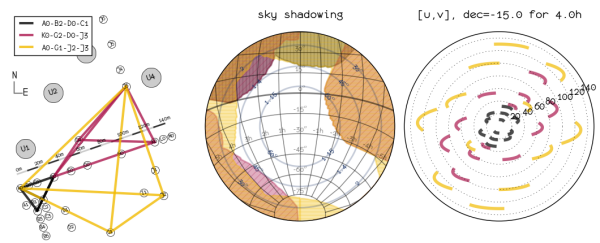VLTI Configurations Overview
Configurations offered using the Auxiliary Telescopes
The users are requested to provide their preferred AT quadruplet in their proposal at phase 1. The quadruplet cannot be changed after proposal submission. In case of the 3 telescope instrument AMBER, the triplet used on sky is set by the OB preparation process in phase 2 (for service mode proposals) and during the run itself for visitor mode observations.
P100:
PIONIER and GRAVITY are offered on the 3 following quadruplets, see figure below for an overview of the telescope stations, sky and u-v plane coverages:
- "large": A0-G1-J2-J3. Note that at the time of offering GRAVITY dual feed observations for P100, there is a uncharacterized visibility loss due to the mix of North and South to the delay line tunnel Stations. ESO might execute your OBs on A0-G1-J2-K0 if the loss is judged too large to be acceptable.
- "medium": D0-G2-J3-K0, except for GRAVITY in dual feed mode
- "small": A0-B2-C1-D0
AMBER is offered with the 12 unique triplets:
P101:
From P101, the astrometric AT configuration is explicitely offered.
The astrometric configuration, A0-G1-J2-K0, is a variation of the standard large configuration A0-G1-J2-J3. The astrometric configuration has all its telescopes south of the delay line tunnel, which is mandatory for GRAVITY dual-feed observations. The following table show which instrument / mode can request which configuration. In order to limit idle time, service mode programs requesting the Large configuration might see their observations executed on the Astrometric instead (similar baseline length and sky coverage).
| AT Configurations | AMBER, PIONIER, GRAVITY single-feed |
GRAVITY dual-feed |
| Small (A0-B2-C1-D0) |
yes | yes |
| Medium (D0-G2-J3-K0) |
yes | no |
| Large (A0-G1-J2-J3) |
yes | no |
| Astrometric (A0-G1-J2-K0) |
no | yes |
Configurations offered using the Unit Telescopes
PIONIER and GRAVITY are offered on the quadruplet UT1-UT2-UT3-UT4.
AMBER is offered on all four available UT triplets:
Configurations from previous periods
For reference, the configurations used in the previous periods can be found on this page.
Observations preparations
For details on the offered modes please refer to the current Call for Proposals and the VLTI manual. In all cases, please verify your observations with ESO tool VisCalc, or alternatively, with the third party preparation software Aspro2, developped with inputs from ESO.

